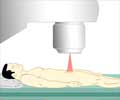
What is Stereotactic Body Radiotherapy?
SBRT is a treatment approach that delivers high doses of radiation to precise areas of a tumor, minimizing damage to surrounding normal cells. Patients receiving SBRT often have less toxicity and side effects compared to treatment with conventional radiotherapy that is delivered in smaller doses each day over several weeks.‘Stereotactic body radiotherapy is most widely used to treat early stage lung neuroendocrine tumors.’
Tweet it Now
“SBRT is commonly used as a treatment for early stage non-small cell lung cancer, and our results show strong tumor control. This suggests that SBRT may also be effective for lung neuroendocrine tumors,” said Oliver, assistant member of the Department of Radiation Oncology at Moffitt.” They performed a retrospective analysis of 48 lung neuroendocrine tumors from 46 patients who were treated with SBRT from 11 institutions across the U.S. The researchers discovered that SBRT provided strong local/regional tumor control.
The three-, six- and nine-year local control rates with SBRT were 97%, 91% and 91% respectively, and only one regional recurrence occurred. The treatment was also well tolerated with only one case of SBRT-related toxicities reported, which was considered low-grade.
Since lung neuroendocrine tumors are so rare, it is difficult to conduct clinical trials for these patients. Therefore, a randomized trial will likely never be conducted to compare SBRT to surgery. Despite this, the results from the study are comparable to historical populations of lung neuroendocrine tumor patients who were treated with surgery, which is particularly notable given that many patients treated with SBRT typically have additional health conditions that can make treatment difficult and result in poorer outcomes.
“The current study is the largest and first multi-institutional series evaluating local control, toxicity and dosimetric outcomes with SBRT for early stage lung neuroendocrine tumors. Our results suggest that while surgery provides excellent outcomes, SBRT should be considered another treatment option for this patient population,” said Rosenberg, study senior author and director of MRI guided radiotherapy in Moffitt’s Department of Radiation Oncology.
Advertisement















